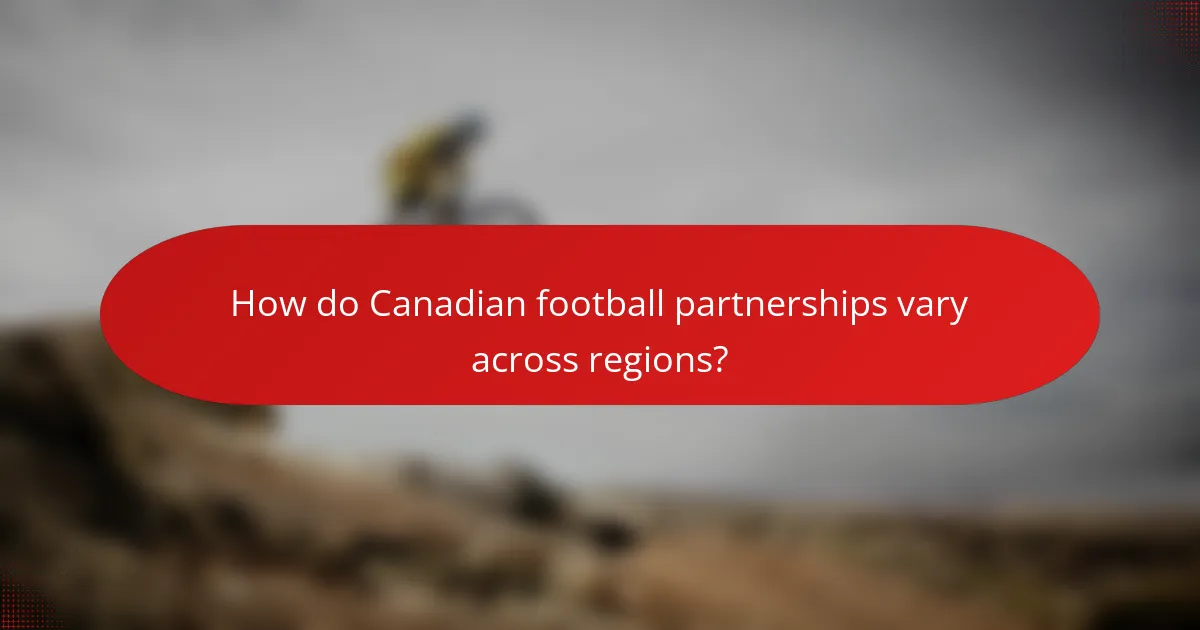Canadian football partnerships with schools enhance student engagement through resources, mentorship, and participation opportunities. These collaborations provide access to professional coaches, workshops, and community events. They also face challenges like funding limitations and varying administrative support. Regional differences shape these partnerships, tailoring them to local needs and promoting both athletic and academic success.

How do Canadian football partnerships enhance student engagement with sports?
Canadian football partnerships enhance student engagement with sports by providing resources, mentorship, and opportunities for participation. These collaborations create a supportive environment that fosters teamwork and physical activity.
Partnerships often include workshops, training sessions, and game-day experiences, which directly involve students in the sport. This hands-on approach increases interest and participation rates in physical education programs.
Schools benefit from access to professional coaches and athletes, who serve as role models and inspire students. The unique attribute of these partnerships lies in their ability to connect students with local teams, promoting community spirit and pride.
As a result, student engagement in sports not only improves physical health but also develops essential life skills such as leadership and collaboration.
What are the key benefits of these partnerships for schools?
Partnerships between Canadian football organizations and schools provide numerous benefits, enhancing educational experiences. These collaborations promote physical fitness, teamwork, and social skills among students. They also offer access to coaching resources and mentorship programs, fostering personal development. Additionally, schools gain community engagement and support, strengthening local ties.
How do partnerships improve physical education programs?
Partnerships enhance physical education programs by providing resources, expertise, and opportunities for students. Canadian football’s collaborations with schools improve facilities, increase student engagement, and create pathways for athletic scholarships. These partnerships often include coaching clinics, equipment donations, and organized competitions, fostering a supportive environment for physical education. As a result, students gain access to quality training and mentorship, promoting overall health and fitness.
Which Canadian football organizations are actively involved in school partnerships?
The Canadian Football League (CFL) and various teams actively engage in partnerships with schools. Organizations like the BC Lions, Toronto Argonauts, and Calgary Stampeders collaborate with educational institutions to promote physical education and healthy lifestyles. These partnerships often involve workshops, mentorship programs, and community outreach initiatives. The goal is to enhance student engagement through football-related activities and resources.

What unique programs do Canadian football teams offer to educational institutions?
Canadian football teams offer unique programs that enhance educational experiences. These partnerships often include mentorship initiatives, skill development workshops, and community engagement projects. For example, teams may provide coaching clinics for physical education teachers, promoting sportsmanship and teamwork among students. Additionally, they may host educational events that focus on health, nutrition, and fitness. Such collaborations foster a stronger connection between sports and education, benefiting both students and the teams involved.
How do mentorship programs connect players with students?
Mentorship programs connect players with students by facilitating direct interactions and skill-sharing opportunities. These programs enhance students’ understanding of sports while providing players with leadership experience. Canadian football teams collaborate with schools to create structured mentorship initiatives, fostering community engagement and personal development. As a result, students gain valuable insights into teamwork, discipline, and athleticism, while players enhance their communication and mentoring skills.
What role do community outreach initiatives play in these partnerships?
Community outreach initiatives are crucial in enhancing Canadian football’s partnerships with schools and educational institutions. They foster engagement, promote physical activity, and build a sense of community. Programs such as workshops and clinics provide students with access to coaching and mentorship from professional athletes. These initiatives often lead to increased participation in sports, improving students’ physical health and teamwork skills. Furthermore, they create pathways for academic scholarships and career opportunities in sports-related fields. Overall, these partnerships strengthen community ties and promote the values of teamwork and perseverance among youth.

Which challenges do Canadian football partnerships face in schools?
Canadian football partnerships in schools face challenges such as funding limitations, lack of resources, and varying levels of administrative support. These obstacles hinder program development and student engagement. Additionally, differing priorities between educational institutions and sports organizations can complicate collaboration. Cultural perceptions of football also influence participation rates and program sustainability.
How do funding limitations impact program availability?
Funding limitations significantly reduce program availability for Canadian Football partnerships with schools. These financial constraints hinder access to resources, training, and facilities necessary for effective collaboration. As a result, fewer students participate in football programs, impacting overall engagement and development. Limited funding can also affect the quality of coaching and equipment, further diminishing program effectiveness.
What are the common barriers to student participation in football programs?
Common barriers to student participation in football programs include lack of access, financial constraints, and time commitments. Many students face challenges such as insufficient facilities, transportation issues, and competing extracurricular activities. Additionally, some may lack encouragement from peers or parents, impacting their willingness to engage. Programs can address these barriers by fostering partnerships with schools to enhance accessibility and support.

How do Canadian football partnerships vary across regions?
Canadian football partnerships with schools and educational institutions vary significantly across regions. In western Canada, partnerships often focus on community engagement and youth development, emphasizing accessibility and participation in local leagues. In contrast, eastern Canada tends to prioritize academic collaboration, integrating football programs into school curricula to promote physical education.
Central Canada showcases a blend of both approaches, with partnerships fostering competitive teams while also supporting educational initiatives. Additionally, northern regions may face unique challenges, such as limited resources, leading to innovative partnerships that leverage technology for remote training and education.
Overall, these regional differences highlight how Canadian football adapts to local needs, creating tailored partnerships that enhance both sports and education.
What regional differences exist in partnership structures and outcomes?
Regional differences in partnership structures and outcomes in Canadian football reflect varying levels of engagement with schools. In urban areas, partnerships often involve comprehensive programs that integrate football into physical education, while rural regions may focus on community-based initiatives.
Urban institutions typically have access to greater resources, enabling them to offer advanced training facilities and coaching expertise. Conversely, rural partnerships may emphasize accessibility and inclusivity, fostering local talent through grassroots efforts.
Outcomes also differ; urban partnerships often yield higher participation rates and competitive success. In contrast, rural areas may prioritize community cohesion and personal development over performance metrics.
These disparities highlight the unique attributes of each region, shaping the effectiveness and reach of Canadian football’s educational partnerships.
How do cultural attitudes toward football influence school partnerships?
Cultural attitudes toward football significantly shape school partnerships by fostering community engagement and promoting teamwork. In Canada, football is viewed as a tool for character development, encouraging schools to collaborate with local teams. These partnerships often emphasize values like discipline and leadership, enhancing students’ educational experiences. Schools benefit from access to coaching resources and facilities, while football programs gain visibility and support. As a result, these collaborations strengthen ties between educational institutions and communities, promoting a positive outlook on sports and physical education.

What are the long-term impacts of Canadian football partnerships on students?
Canadian football partnerships with schools positively impact students long-term by enhancing physical health, teamwork skills, and academic performance. These partnerships provide access to resources, coaching, and facilities that promote active lifestyles.
Students involved in Canadian football programs report improved fitness levels, with participation leading to a 30% increase in physical activity compared to non-participants. Additionally, teamwork and leadership skills gained through these programs translate into better collaboration in academic settings.
Research shows that students engaged in sports, including football, achieve higher grades and have lower dropout rates. These benefits underscore the unique attribute of Canadian football partnerships in fostering both athletic and academic excellence.
As a result, schools that collaborate with Canadian football organizations create a supportive environment that nurtures student development beyond the classroom.
How do these partnerships contribute to student development and life skills?
Partnerships between Canadian football organizations and educational institutions significantly enhance student development and life skills. These collaborations foster teamwork, discipline, and leadership through organized sports programs.
Students gain valuable experiences that translate into real-world skills. For instance, participation in team sports promotes collaboration and communication. Additionally, mentorship opportunities through these partnerships encourage personal growth and resilience.
Research indicates that students involved in sports are more likely to achieve academic success and develop strong social networks. These partnerships also provide access to resources, such as coaching and training, which further enrich student experiences.
Overall, the integration of Canadian football into educational settings cultivates essential life skills that benefit students beyond the classroom.
What success stories highlight the benefits of football partnerships in education?
Canadian football partnerships with schools enhance educational outcomes through improved student engagement and teamwork skills. For instance, programs like the CFL’s School Program offer resources that promote physical health and academic achievement. Schools report increased attendance and participation in sports, fostering a sense of community. Additionally, mentorship initiatives connect players with students, providing role models and inspiring youth to pursue their goals. These partnerships demonstrate the unique ability of football to positively impact education and personal development.
What best practices can schools adopt to maximize the benefits of these partnerships?
Schools can maximize the benefits of Canadian football partnerships by implementing targeted strategies. Establishing clear communication channels fosters collaboration between coaches and educators. Regular workshops can enhance understanding of the sport’s educational value. Integrating football into physical education curricula promotes student engagement and physical fitness. Additionally, leveraging community events strengthens the bond between schools and local teams, creating a supportive environment for student-athletes. Finally, evaluating partnership outcomes ensures continuous improvement and alignment with educational goals.
